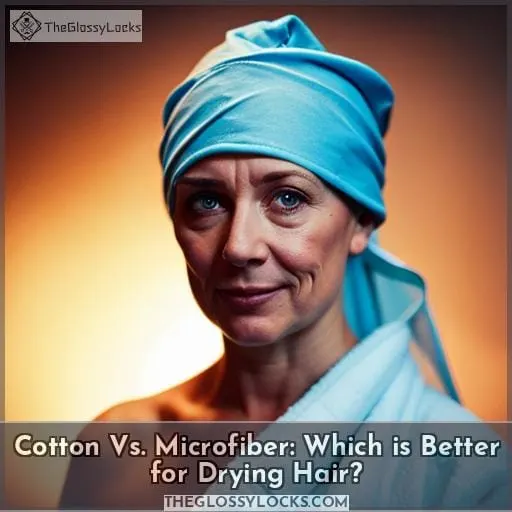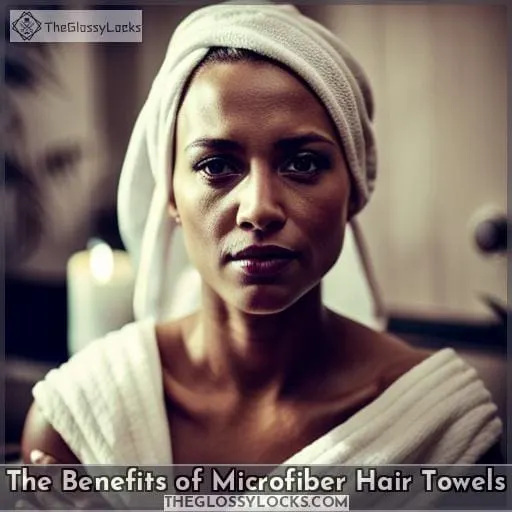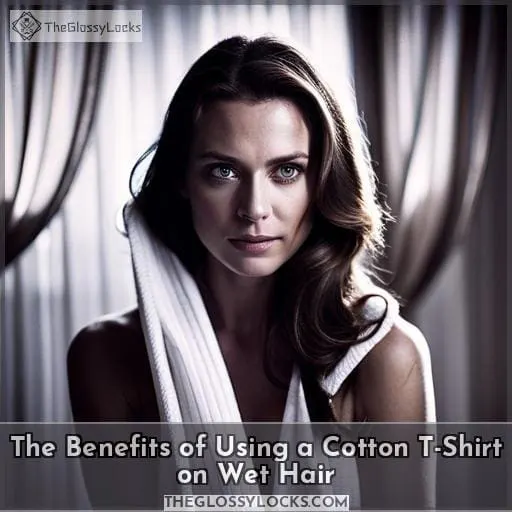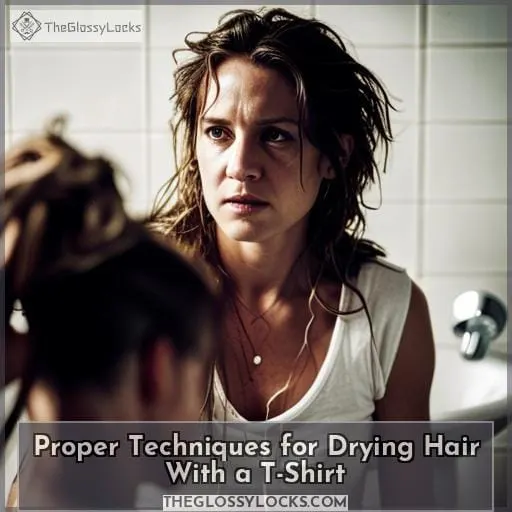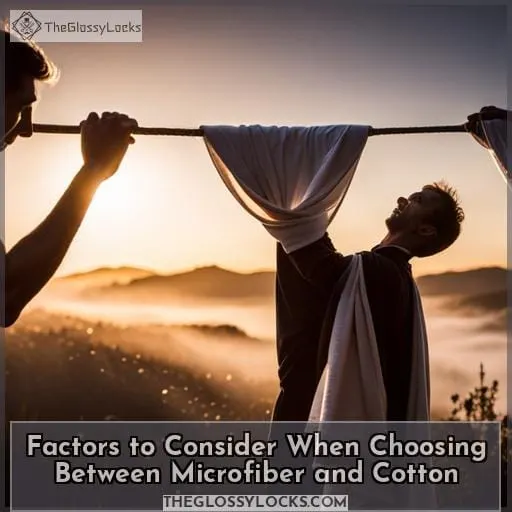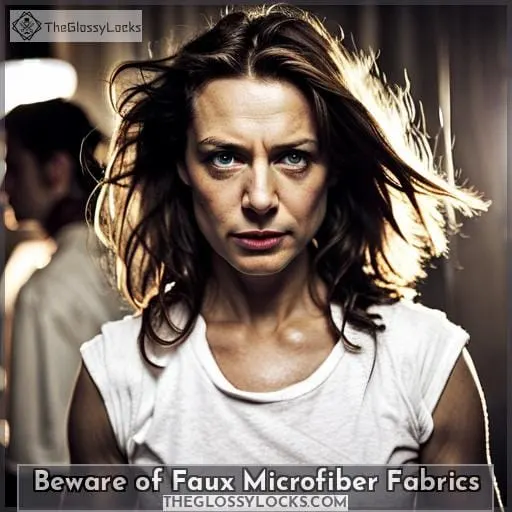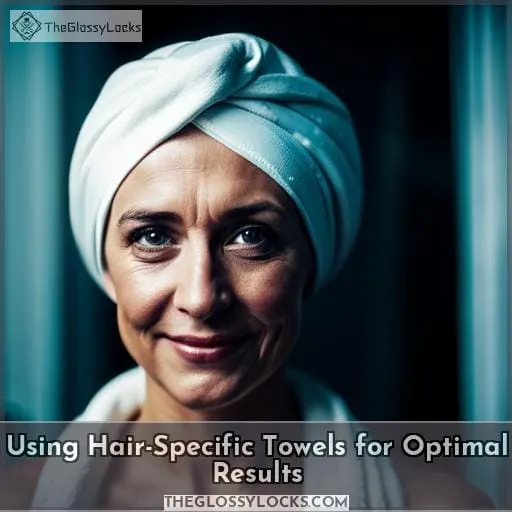This site is supported by our readers. We may earn a commission, at no cost to you, if you purchase through links.
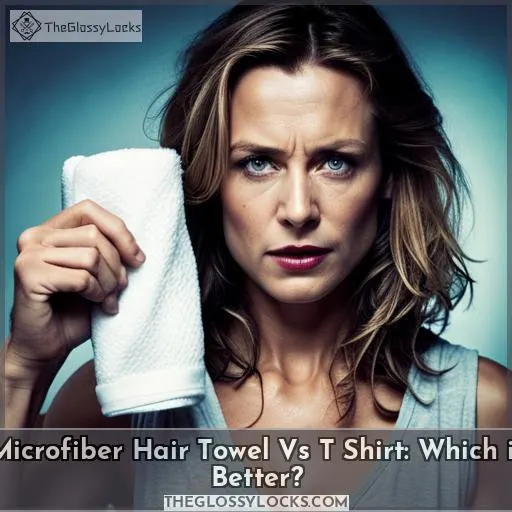 Are you looking for the best way to dry your hair? It’s a struggle all too familiar – wet hair that takes forever to air-dry, causing frizz and breakage.
Are you looking for the best way to dry your hair? It’s a struggle all too familiar – wet hair that takes forever to air-dry, causing frizz and breakage.
When it comes down to microfiber hair towels vs t-shirts, which one should you choose? Read on as we explore the benefits of each material and provide helpful tips for drying your precious locks without damage or dreaded frizz.
From proper techniques with t-shirts, faux microfiber fabrics to watch out for, and more – this guide will help you decide which method is right for your individual needs!
Table Of Contents
- Key Takeaways
- Cotton Vs. Microfiber: Which is Better for Drying Hair?
- The Benefits of Microfiber Hair Towels
- The Benefits of Using a Cotton T-Shirt on Wet Hair
- Proper Techniques for Drying Hair With a T-Shirt
- Factors to Consider When Choosing Between Microfiber and Cotton
- Beware of Faux Microfiber Fabrics
- Using Hair-Specific Towels for Optimal Results
- Additional Considerations for Drying Hair
- Microfiber Hair Towels Vs. T-Shirts: Which Will You Choose?
- Conclusion
Key Takeaways
- Microfiber hair towels are more gentle on hair compared to t-shirts.
- Microfiber towels are more absorbent and can reduce frizz.
- Using a microfiber hair towel can help dry hair faster than using a t-shirt.
- It is important to choose genuine microfiber towels to ensure effectiveness.
Cotton Vs. Microfiber: Which is Better for Drying Hair?
When it comes to drying your hair, traditional terry cloth bath towels can do more harm than good. Cotton hair towels minimize friction and are a much safer option for wet, fragile strands, while microfiber towels are especially gentle on the delicate hairs of your head.
Traditional Terry Cloth Bath Towels Can Damage Hair
To protect your hair from damage, it’s best to avoid traditional terry cloth bath towels and opt for more gentle drying options:
- Cotton hair towels minimize friction.
- Microfiber absorbs 7x its weight in water and is gentle on strands.
- T-shirts are a safe option too.
- Straight or long/thick locks may benefit from microfiber wraps with hydrating masks for added moisture retention & frizz control.
Be sure to use a light touch when drying!
Cotton Hair Towels Minimize Friction
You’ll be amazed at how your hair glides through the turban-style cotton towels, like butter! Cotton and microfiber offer superior frizz control compared to terry cloth bath towels. Turban-style options are great for wrapping up hair without causing friction or breakage.
Hair wraps made of quality cotton are affordable and protect against damage while drying.
Microfiber Towels Are Gentle on Hair
Discover how a microfiber towel is gentler on your hair than a t-shirt for damage-free drying. The weave of microfiber towels creates less friction, reducing frizz and protecting vulnerable hair strands.
Its superior absorbency means it pulls more moisture out of your locks compared to cotton T-shirts.
Plus, the tight fibers are gentle enough for all types of curl care or textured styles without causing any disruption in the natural pattern or texture.
Consider adding one into your regular hair care routine as an alternative option that’s both safe and effective when it comes to drying off after showering or swimming!
The Benefits of Microfiber Hair Towels
Are you looking for a better way to dry your hair without causing damage? Microfiber towels are gaining popularity due to their superior ability to absorb water quickly and prevent friction that causes frizz.
Compared to traditional cotton t-shirts, microfiber towels offer more absorbency, softness, and the ability to shape themselves for optimal drying – making them an ideal choice for those with curly or long hair.
Microfiber Towels Absorb Water Faster
Compared to traditional cotton towels, microfiber cloths absorb water more quickly and efficiently. The superior absorption efficiency of these materials makes them ideal for proper hair drying, regardless of hair type.
In addition to promoting faster drying times, they also offer better frizz control than a standard towel choice by absorbing excess moisture from delicate strands. When it comes to material comparison between microfiber vs cotton towels for proper hair care, the former is clearly the superior option due to its added benefits in terms of speed and hydration retention capabilities.
Microfiber Towels Reduce Friction and Prevent Frizz
Slip into the luxurious softness of a microfiber towel and feel your hair’s frizz fade away. Microfiber towels provide an unbeatable option for reducing friction and preventing frizz.
- More absorbent
- Soft yet strong
- Shape easily around the head
- Lock in moisture when used with hydrating masks. Allowing you to care for your hair without damaging it or causing any extra stress on strands!
Microfiber Towels Are More Absorbent and Soft
Your hair will appreciate the extra softness and absorbency of a microfiber towel. Whether you have curly or straight hair, it’s important to consider how your drying method affects its condition.
Microfiber towels are designed with a tight weave, making them more gentle on the strands than traditional terry cloth bath towels while still absorbing excess water quickly. This also helps reduce lint transfer from the towel onto your head when used correctly.
Furthermore, these lightweight materials make them perfect for travel—no need to lug around bulky cotton t-shirts! Invest in quality microfiber towels for optimal results in protecting and styling your locks.
The Benefits of Using a Cotton T-Shirt on Wet Hair
When it comes to wet hair, cotton t-shirts are a great option for drying. Not only do they help reduce frizz and provide gentle care for curls, but they also cause less friction than microfiber towels.
Additionally, cotton t-shirts are an affordable choice when looking to dry your hair without causing damage.
Cotton T-shirts Are Gentle on Curls and Reduce Frizz
Gently wrap your curls in a cotton t-shirt and let the fabric reduce frizz. Curl-friendly options, such as hair wraps and microfiber towels, offer moisture retention while drying techniques help tame flyaways.
Frizz reduction is key when using a cotton t-shirt – it works to maintain hair texture without causing damage or breakage.
Cotton T-shirts Cause Less Friction Than Microfiber
Unlike microfiber, a cotton T-shirt won’t tug or pull at your hair as you dry it. Cotton benefits include less friction and frizz control when drying. It also protects against breakage while using hydrating masks and is more affordable than hair-specific towels.
Microfiber’s absorbency makes it great for thick or long locks but can cause damage to delicate strands over time due to its tight weave.
Cotton T-shirts Are an Affordable Option for Drying Hair
A cotton t-shirt is an affordable and easy way to dry your hair without sacrificing protection. Cotton fabric absorbs more water than microfiber towels, making it a great option for long or thick hair.
It’s also gentle on curls, reducing the risk of frizz and breakage due to friction.
Proper Techniques for Drying Hair With a T-Shirt
Drying your hair with a t-shirt can be an effective way to prevent damage while keeping your locks looking healthy. Learn the proper techniques for drying wet hair with a t-shirt, including steps for plopping curly hair and tips to reduce frizz and breakage.
How to Dry Hair With a T-shirt
To perfect your drying technique, try using a T-shirt to protect and style wet hair. Plopping is an effective curly hair care method that uses gravity to produce curls with minimal frizz. For straight or wavy hair, gently wrap the T-shirt around damp strands for extra hydration and protection from breakage.
When selecting a towel, choose microfiber for maximum absorbency or cotton for gentleness on fragile locks.
Steps for Plopping Curly Hair With a T-shirt
Grab a T-shirt and start plopping your curls for frizz-free locks! Plopping is an effective technique to dry curly hair without damaging it. Use a T-shirt or microfiber towel. Lay them flat on the counter. Then gather your wet curls in the center and carefully roll onto the fabric.
Secure with elastic bands at each end of the curl roll to keep it together while drying.
This can be done standing up as well. Just hold both ends of the t-shirt up around your head, letting gravity do its job until dry.
Tips to Reduce Frizz and Prevent Breakage
By using a t-shirt to dry your hair, you can help reduce frizz and breakage with the power of gentle plopping. Opt for a cotton or microfiber t-shirt, as both are gentle on curls. Consider using a Turbie Towel – its unique shape helps prevent lint transfer while locking in moisture when used with hydrating masks.
Additionally, try towel drying from root to tip instead of rubbing harshly against strands, which can cause increased frizz and damage.
Factors to Consider When Choosing Between Microfiber and Cotton
When it comes to drying your hair, you have two options: a cotton t-shirt or a microfiber towel. Both can help protect against frizz and breakage, but depending on the condition of your hair, one may be better than the other.
For example, straight hair can benefit from either material, while long or thick locks should opt for microfiber due to its water-absorbing capabilities. Damaged strands require extra TLC in the form of a gentler option like microfiber towels.
Straight Hair Can Use Either a T-shirt or Microfiber Towel for Frizz Control
Whether you have straight hair or curls, both a t-shirt and microfiber towel can help reduce frizz. With the right choice of fabric for your hairstyle, you can dry your locks without causing damage.
Microfiber towels are gentle and absorb seven times their weight in water. T-shirts made of cotton will provide friction but won’t cause frizz like regular bath towels might do.
No matter which option you choose, be sure to handle wet strands delicately for optimal results when drying your mane!
Microfiber is Preferable for Long or Thick Hair Due to Its Water-absorbing Ability
If you have long or thick hair, microfiber towels can be an ideal choice as they absorb more than seven times their weight in water.
- Hair thickness comparison with less frizz for curls;
- Superior absorption of moisture;
- Benefits for longer hair due to its water-absorbing ability. Microfiber is a highly recommended material when choosing a towel specifically designed for your hair needs while protecting from further damage that regular bath towels may bring.
Consider the Condition of Your Hair (damaged or Healthy) When Choosing a Drying Method
When deciding between a microfiber hair towel and a cotton t-shirt for drying your locks, consider the condition of your strands. Hair health affects which technique is best suited to retain moisture and control frizz.
For damaged hair, choose a gentle drying method like microfiber to reduce heat usage, whereas healthy hair can use either option depending on desired results. Microfiber wraps can lock in hydration when used with hydrating masks, while T-shirts provide less friction but are not as absorbent as towels.
Beware of Faux Microfiber Fabrics
When it comes to hair care, genuine microfiber towels are a must-have. It’s important to know the differences between genuine and faux microfiber fabrics, as well as how to identify them so you can be sure you’re investing in quality products that will protect your hair from damage.
The Importance of Using Genuine Microfiber Towels
Using genuine microfiber towels is essential for protecting your hair from damage and achieving optimal results. Identifying the real thing can be tricky, so look out for a tight weave that won’t snag on delicate strands.
Microfiber’s absorbency makes it ideal for frizz prevention, plus its softness helps when using drying techniques like plopping curls into shape. Hair-specific towels are also beneficial to tailor to different hair types or curl patterns.
Differences Between Genuine and Faux Microfiber Fabrics
It’s important to be aware of the differences between genuine and faux microfiber fabrics, so you can rock your coif with confidence. Genuine microfiber is made from ultra-fine fibers that are soft yet absorbent – perfect for curly locks! Faux looks similar but lacks the benefits as it’s often too scratchy or not very absorbent.
Different hair types require different towels; look for a towel specifically tailored to your strands, then use proper drying techniques with a hydrating hair mask to keep curls healthy and hydrated.
How to Identify Genuine Microfiber Towels
To ensure you get the best experience with your hair towels, make sure to identify genuine microfiber so that you can reap all of its benefits.
Compare material types and inspect for softness, thickness, and weight-absorbency ratio before purchasing one.
Microfiber care tips are essential too: avoid harsh detergents or fabric softener; air dry after washing; replace frequently when needed – these will guarantee durable results!
With proper identification of authentic microfiber products in hand, you’re well on your way to achieving optimal drying while avoiding damage from lint transfer and friction.
Using Hair-Specific Towels for Optimal Results
Looking for the best way to protect your hair from damage while drying? Using towels specifically designed for hair can offer a lot of benefits. Hair-specific towels are created with special materials and designs that help reduce friction, absorb moisture quickly, and prevent breakage due to improper drying techniques.
High-quality options are available in both microfiber and cotton varieties so you can find the right one for your needs.
The Benefits of Using Towels Specifically Designed for Hair
You’ll be surprised by the difference using a towel specifically designed for hair can make. Hair-specific towels offer many benefits, from preventing damage and breakage to reducing frizz.
Microfiber is gentle on curls and absorbs water quickly, while cotton t-shirts are an affordable option that reduce friction.
With proper care, high-quality microfiber wraps lock in moisture when used with hydrating masks – perfect for those with damaged hair!
Drying techniques should also be considered. Experiment with plopping or scrunching curly locks to find the best fit.
Proper use of these towels will leave you feeling confident, knowing your locks are healthy, strong, and shiny!
How Hair-specific Towels Can Protect Against Damage
By using hair-specific towels, you can protect your mane from damage while drying. Look for materials like cotton and microfiber that are gentle on strands, absorb water quickly, and avoid friction.
Take care of them properly by washing after use to prevent bacteria buildup. Consider different methods such as plopping or scrunching curls to reduce frizz and breakage when drying.
Use a towel specifically designed for your hair type. For long, thick locks, an ultra-absorbent microfiber wrap may be necessary.
Shop around wisely to find the right fit for you, including quality budget options too!
Where to Find High-quality Hair Towels
Finding the right towel for your hair can be tricky, but with a little research, you’ll be able to find high-quality towels that suit your needs – just like finding a needle in a haystack! The best brands offer luxurious microfiber and cotton options online, along with affordable picks.
Additional Considerations for Drying Hair
When drying your hair, it is important to be gentle and avoid any rubbing or wringing. A microfiber wrap can help lock in moisture when used with hydrating masks, while experimenting with different products and techniques may reveal what works best for your own individual needs.
Be Gentle With Your Hair When Drying, Avoiding Rubbing and Wringing
Gently pat your hair with the towel instead of rubbing or wringing it to avoid breakage. To protect from frizz, moisture loss, and damage, use gentle drying techniques; avoid heat styling; lock in hydration with a mask while microfiber wraps help retain moisture.
Using Microfiber Wraps to Lock in Moisture With Hydrating Hair Masks
Using a microfiber wrap and hydrating hair masks together can help lock in moisture, giving your locks hydration benefits. The tight weave of a microfiber towel helps the mask stay put until it has time to work its magic.
Hair care products penetrate better when follicles are damp, delivering maximum nourishment and hydration for silky soft strands. The high absorbency rate of microfibers is also great for locking in ingredients from conditioners or leave-in treatments while preventing frizziness throughout the day.
Experiment With Different Drying Techniques and Products to Find What Works Best for Your Hair
Try out different drying techniques and products to find the one that works best for you! Hair product recommendations, heatless styling, hair care routines, detangling methods, and hair straightening techniques are all worth exploring.
Investigate hydrating masks or leave-in conditioners to reduce friction when blow-drying or using a flat iron. Experiment with air-drying options like plopping or braiding wet strands overnight.
Microfiber Hair Towels Vs. T-Shirts: Which Will You Choose?
When it comes to drying your hair, there are two main options: microfiber towels and cotton t-shirts. It’s important to consider your hair type and specific needs when deciding which one is best for you as both have their advantages.
Furthermore, finding a method that works for you ensures the health of your locks while preventing damage from excessive heat or friction.
Consider Your Hair Type and Specific Needs When Deciding Between Microfiber and Cotton
When choosing between microfiber and cotton, consider what type of hair you have and if either will meet your specific needs.
Curly haired folks should opt for something like genuine microfiber to reduce friction while drying, as well as retain moisture with hydrating masks.
Wavy locks may require different techniques for optimal results. Experiment with products and plopping methods to find the best solution.
Depending on your individual needs, one option might be more suitable than the other – so weigh up both options before making a decision!
The Importance of Finding a Drying Method That Works for You
Finding the right drying method for your hair is key to protecting it from damage and achieving a healthy look. Consider your hair care preferences when selecting between microfiber towels, cotton t-shirts, or other fabrics.
Different techniques can be used with each material to personalize the drying process and reduce frizz or breakage.
Experimentation will help you find out which methods work best for you. This could range from plopping curls with a t-shirt to using wraps made of high-quality cotton fabric for long, thick locks.
Shop for Microfiber Towels and Hair
Forget the ordinary—it’s time to upgrade your hair care routine with luxurious microfiber towels and hair wraps! Shop for genuine microfiber towels, designed to absorb seven times their weight in water while being gentle on delicate strands.
Cotton t-shirts are an alternative but may cause friction and frizz. Look for hair-specific options that offer optimal drying and breakage prevention.
Conclusion
Finding the best way to dry your hair can be challenging, but the difference between microfiber hair towels and cotton t-shirts is clear. Microfiber towels can absorb seven times their weight in water, reducing friction and frizz, while cotton t-shirts are gentle on curls and cause less friction.
Both are good options, but depending on your hair type and condition, one may be better than the other. Consider the benefits of both, such as microfiber’s superior water-absorbing ability and cotton’s affordability, and experiment with different drying techniques and products to find what works best for you.
With the right hair towel, you can avoid breakage and keep your hair looking healthy and beautiful.

